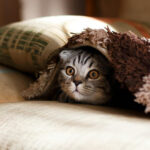Does your feline friend seem to have a never-ending craving for chewing on everything in sight? Understanding “Why Does My Cat Chew On Everything” is crucial for any cat owner. Solcat.net is here to explore the various reasons behind this behavior, from natural instincts to potential underlying issues, and provide practical solutions to keep your kitty safe and your belongings intact. Let’s dive in and discover the root causes and effective strategies for curbing this habit, ensuring a happier, healthier life for your beloved companion and a more peaceful home for you with expert advice on feline dental health and behavioral adjustments!
1. Is Chewing Normal Behavior for Cats?
Yes, chewing is a normal behavior for cats in many situations. In fact, it is linked with their eating habits. As true carnivores, their bodies are specifically adapted for a diet primarily composed of meat. This inherent preference for animal-based meals not only influences their food choices but also their tendency to nibble on non-food items.
1.1. How Cat Eating Habits Influence Chewing
A cat’s eating habits and chewing behavior are closely related; both are intertwined with their natural instincts and dietary needs. Because their bodies are built for a meat-heavy diet, chewing and tearing through prey, such as birds or rodents, is an essential part of their natural hunting behavior. Even domesticated cats retain these instincts.
According to a study by the Cornell Feline Health Center in July 2025, cats’ natural hunting instincts often lead them to chew on objects that mimic the texture of prey. Your cat’s diet can also influence their chewing habits. Cat parents know that their kiddos can be very picky, and many have particular preferences for certain textures or flavors. You may notice your cat chewing more if they enjoy the sensation of a specific type of food or treat.
1.2. When Chewing on Non-Food Items Is Normal
If you catch your cat munching on things that are definitely not food, don’t worry. There are plenty of times when this is totally normal. For starters, kittens are avid explorers, and chewing is their way of getting to know the world. It’s all part of the learning process. Then there’s teething; just like human babies, kittens go through it, too, and chewing can help soothe their sore gums during this phase.
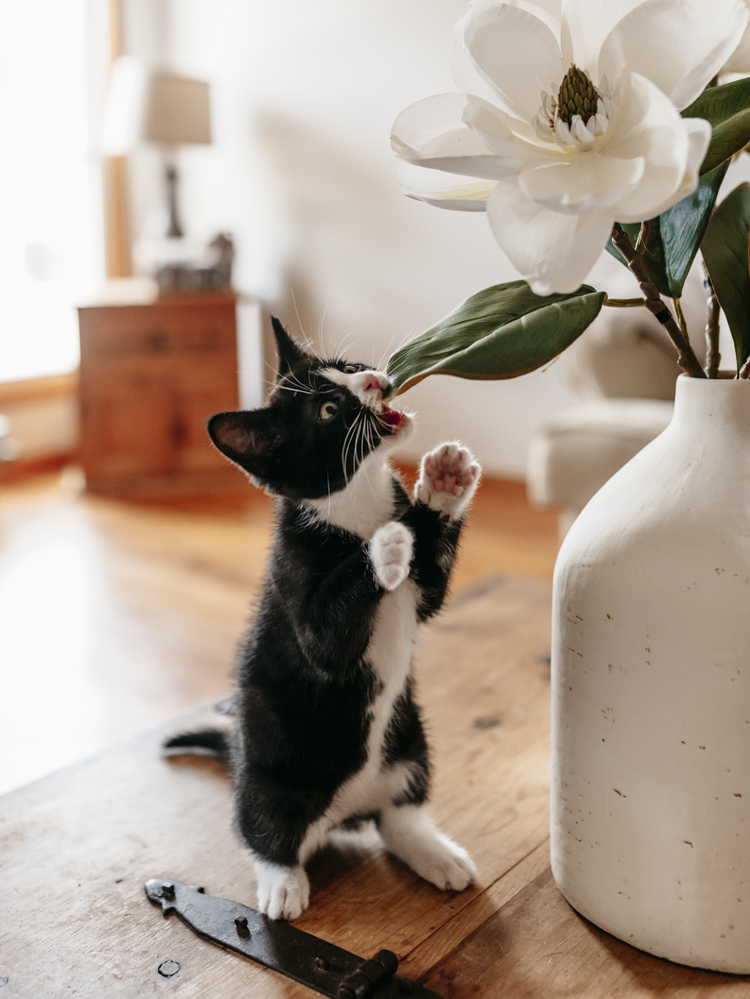
As they grow, it can also help keep those pearly whites in tip-top shape and improve their dental health. Chewing also taps into a cat’s natural hunting instincts. So, if you catch your cat nibbling on a toy or a cardboard box, chances are they’re just embracing their inner predator. Lastly, there’s a strong possibility that good ol’ boredom is to blame for your cat’s chewing. As much as our cats can entertain themselves (much to our amusement), sometimes they need a little extra something to keep them stimulated. Solcat.net offers various articles to keep your feline friend entertained.
2. What Are Other Reasons Why Cats May Chew?
While there are some pretty legit reasons for cat chewing, like their hunting instincts and love for meaty treats, there are situations when cat chewing takes a detour into not-so-normal territory.
2.1. Understanding Pica in Cats
Have you ever noticed your cat munching on things like fabric, plastic, or plants? It’s a behavior known as pica. This intriguing phenomenon involves cats consuming, chewing, or sucking on non-nutritive items, and researchers have been curious about what drives it. Some theories suggest boredom, a lack of social interaction, or perhaps a lingering hunting instinct. Others think genetics or early weaning might play a role. But it’s not a one-size-fits-all situation. Cats with pica vary in their behaviors, with some vomiting more frequently or having an unusually hearty appetite.
Although no one’s conducted a deep-dive study into the medical conditions that might trigger pica in cats, there’s been some interesting talk on the subject. It turns out, certain immune conditions and contagious illnesses have been linked to cats chewing on non-food items, but these studies don’t include information about what was ingested and how. What we do know is that the consumption of non-food items can have relatively serious consequences. Potential concerns linked with pica in cats include:
- Digestive blockages: If your cat decides to ingest items like string, rubber bands, or small objects, there’s a risk of these items causing blockages in their digestive system. These blockages can be quite serious and even life-threatening.
- Toxicity: Some non-food items can be toxic to cats. For instance, certain plants or chemicals can lead to poisoning and result in severe health issues.
- Dental damage: Chewing on hard or abrasive objects can lead to dental problems like tooth damage and wear, causing pain and discomfort.
- Nutritional deficiencies: If your cat’s more into chewing random objects than their actual food, they might miss out on some important nutrients, leading to nutritional imbalances or deficiencies.
- Risk of injury: Cats can choke or inadvertently harm themselves when attempting to chew or swallow non-food items.
If you’re seeing signs of pica in your cat, it’s a good idea to contact your veterinarian or an animal behaviorist to get an accurate diagnosis and get your cat the help they need. Treatment may involve dietary changes, behavior modifications, or medication to treat an underlying condition.
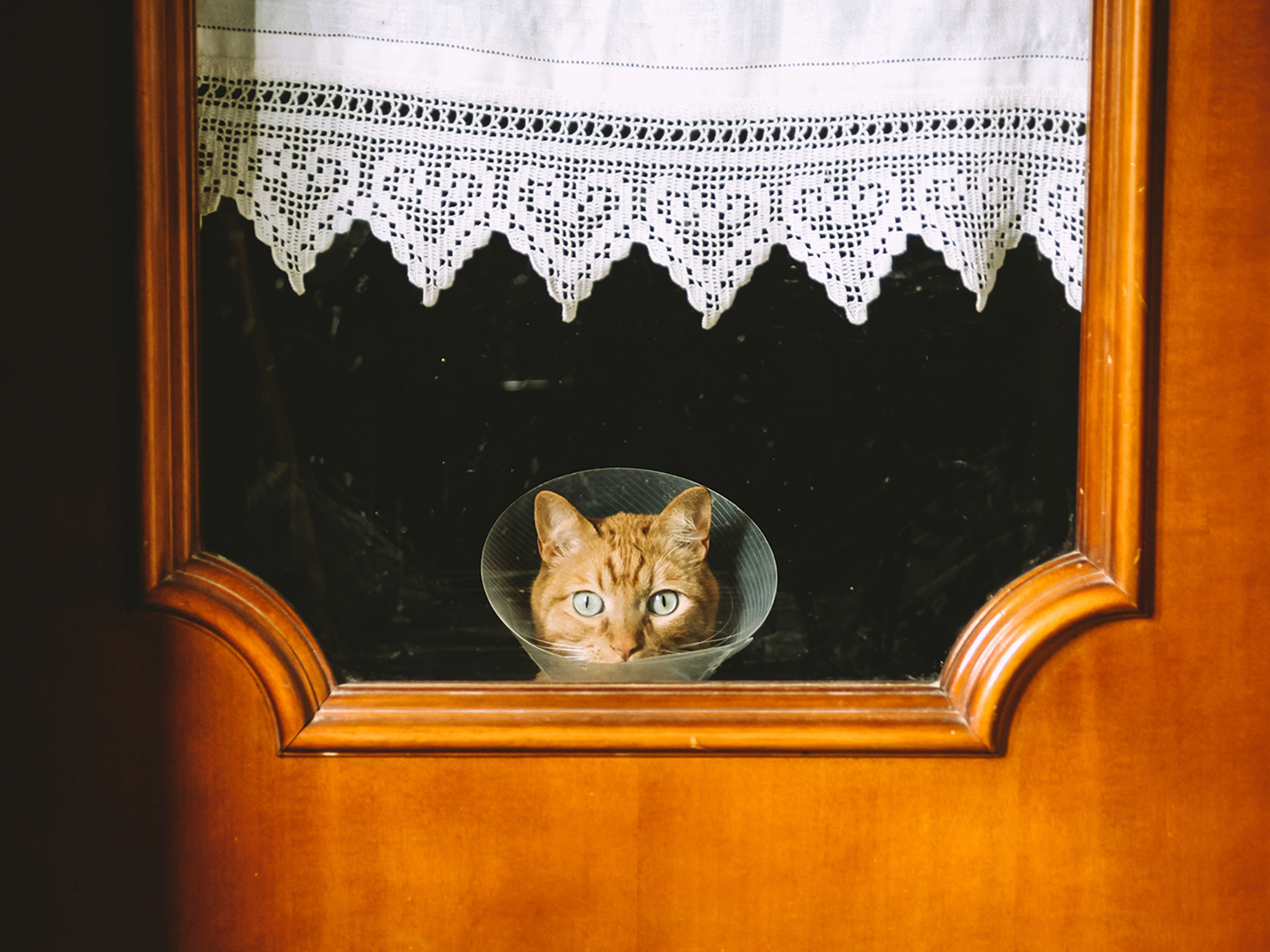 Cat wearing a cone after a vet visit, recovering from treatment
Cat wearing a cone after a vet visit, recovering from treatment
2.2. Cat Periodontal Disease
Chewing can be a way to soothe sore gums if a cat’s experiencing dental pain, or more seriously, periodontal disease. Periodontal disease is a bacterial infection that causes swelling, pain, and sometimes even tooth loss. It can be very painful, so your feline might look for anything to nibble on to get some relief. Keep your eyes peeled for other signs of periodontal disease, including consistent bad breath, pawing at their mouth, difficulty chewing, excessive drooling, changes in weight or appetite, tooth loss, and red, swollen, or bloody gums.
If you notice any of these signs, reach out to your veterinarian and they can examine and treat your cat appropriately. While periodontal disease is unfortunately not treatable, they may suggest a thorough cleaning and regular oral health checkups to prevent any further damage. You should also make teeth brushing and dental treats a regular part of your weekly routine to keep those chompers healthy.
2.3. Exploring Obsessive-Compulsive Disorder (OCD) in Cats
Excessive, repetitive chewing can signal Obsessive Compulsive Disorder (OCD) in cats, which is when your cat engages in repetitive, compulsive behaviors that are often triggered by stress or anxiety. When your kitty just can’t stop the chewing marathon, it might turn into a habit that doesn’t even need a reason to keep going. That’s because their brain gets into the habit of releasing pain-relieving chemicals and reinforces the behavior.
According to the American Animal Hospital Association (AAHA), OCD in cats can manifest as excessive grooming, vocalization, or chewing. Although a cat’s age or gender doesn’t seem to be a factor in having OCD, there are some breeds that are more predisposed to the disorder. Siamese and other Asian breeds, for example, often stand out for their tendency to engage in repetitive behaviors like meowing and fabric-chewing. If you start to notice signs of cat OCD, a vet or animal behaviorist can help relieve some of the symptoms, whether that’s through enrichment and lifestyle changes, behavioral therapy, or medication.
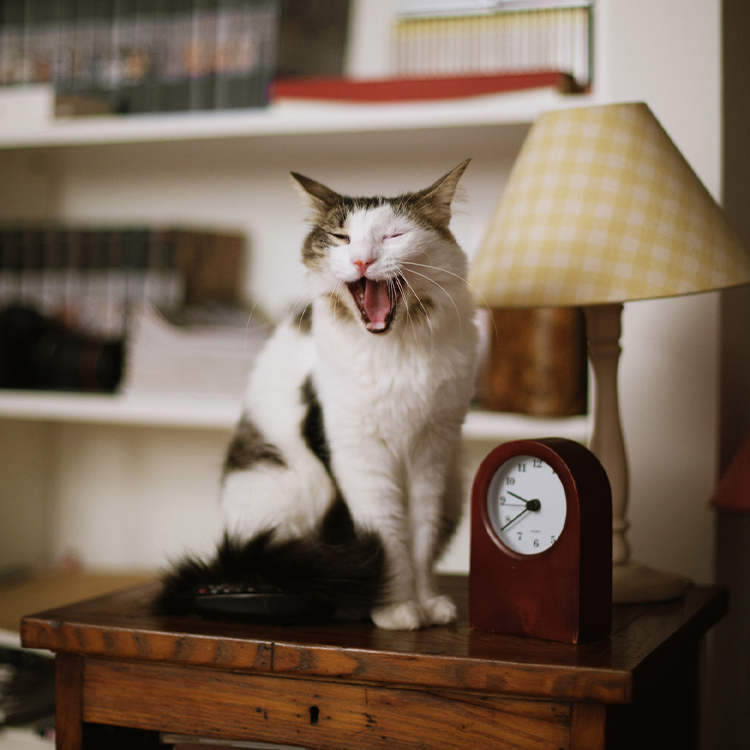 Cat gagging, potentially indicating a health issue that needs attention
Cat gagging, potentially indicating a health issue that needs attention
3. What Are Common Items Cats Chew On?
Cats are curious creatures, so while they’re susceptible to exploring literally anything with their mouths, there are a few items that cats tend to chew on more:
- String or tinsel
- Rubber bands
- Fabric
- Plants
- Cat toys
- Plastic
- Cords and wires
- Furniture
The ones to keep your eyes peeled for are long, string-like objects that can wrap around their intestines or things that can become choking hazards. Aside from toxic food and plants, these tend to be the items that cause the most harm when our feline friends ingest them.
4. When Does Cat Chewing Become Dangerous?
While a munch here and there is totally normal and safe, the risks of cat chewing increase when it starts to cross certain boundaries, both for your feline friend and the environment they live in. For starters, your cat can face dangerous health issues if they start to nibble on the wrong thing. Objects like strings, rubber bands, or even small toys can cause blockages in their digestive system.
This is not only painful but can be life-threatening if not addressed quickly. Then there’s the concern of toxicity. Some non-food items can be downright harmful if ingested. Toxic substances, like certain plants or household chemicals, can lead to poisoning, which requires immediate medical attention.
Beyond the health risks to your cat, there’s the potential for damage to your home environment. Chewing on electrical cords can not only harm your pet but also create safety hazards like electrical fires. Furniture and other valuables can take a major hit, too. So, while a bit of cat chewing can be cute and harmless, it’s a good idea to keep an eye on it. If it starts to escalate into risky territory, it’s time to take action to protect your cat and your home.
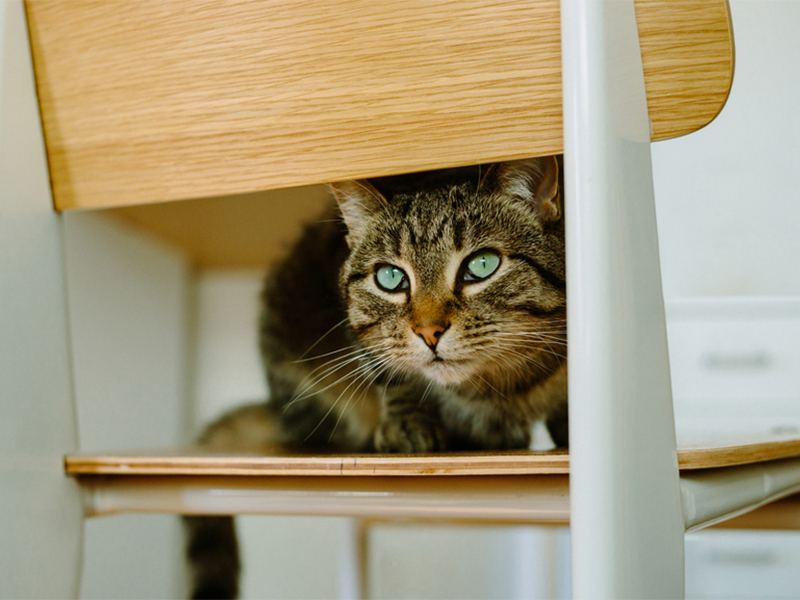 Cat sitting on a kitchen chair, emphasizing the need for a cat-proof home
Cat sitting on a kitchen chair, emphasizing the need for a cat-proof home
5. When Should You Seek Professional Help for My Cat’s Chewing Behavior?
You’re the expert when it comes to your cat, but there are moments when seeking professional help for your cat’s chewing quirks is a wise move. Here’s when to consider reaching out to a vet or animal behavior specialist:
- Excessive or destructive chewing: If your cat’s chewing antics are turning into a full-blown furniture demolition or they’re treating cords like spaghetti, it’s a sign to get some expert advice. This kind of behavior isn’t just about a playful kitty anymore; it can be a real headache and even a safety issue.
- Ingesting non-food items: When your cat starts munching on things they shouldn’t swallow — like strings, rubber bands, or tiny toys — that’s when the alarms should ring. Those objects can lead to serious digestive distress, and we don’t want that.
- Obsessive chewing or repetitive habits: If your cat’s chewing seems more like an obsession and they’re stuck in a loop with other repetitive behaviors, it’s time to chat with a pro. It could be a sign of underlying issues like anxiety or OCD.
- Sudden chewing changes: If your cat’s chewing habits take a U-turn out of the blue, it’s worth checking out. Like, if they were never into chewing and now they’re going at it like a champ — that’s a red flag.
- Chewing discomfort or pain: If your cat looks uncomfortable, in pain, or has strange reactions while chewing (think pawing at their mouth, excessive drooling, or meowing in distress), it’s time to dig deeper. Dental problems or other health issues might be lurking.
- Persistent bad breath: Cats usually don’t have minty-fresh breath, but if your feline’s mouth consistently smells like something out of a horror movie, it’s a sign to get them checked.
Professional help isn’t just for the big stuff. What appears to be a harmless chewing habit could turn serious quickly, so when in doubt, give a vet or a pet behavior specialist a call.
 Siamese cat coughing, a sign that might require veterinary attention
Siamese cat coughing, a sign that might require veterinary attention
6. Practical Tips on How to Prevent Cat Chewing
Despite all the weird ways this peculiar behavior manifests, thankfully, there are a few preventive measures for cat chewing that can make all the difference.
Here is a list of things that can help prevent your cat from chewing:
| Strategy | Description |
|---|---|
| Provide Safe Chew Toys | Offer a variety of toys designed for chewing to redirect their attention from inappropriate items. |
| Enrich the Environment | Ensure your cat has plenty of mental and physical stimulation to reduce boredom and anxiety. |
| Cat-Proof Your Home | Remove or protect items that your cat is likely to chew on, especially electrical cords and toxic substances. |
| Regular Dental Care | Maintain good oral hygiene through regular teeth brushing and dental checkups to prevent dental issues. |
| Consult a Professional | If chewing becomes excessive or destructive, seek advice from a vet or animal behaviorist. |
If your DIY attempts to prevent cat chewing aren’t working, don’t worry — that’s where the pros come in. Vets and pet behaviorists can help you create a customized plan to discourage your curious cat from chewing on everything in sight.
At the end of the day, there are plenty of situations where cat chewing is perfectly normal. But if it’s starting to seem excessive and the fabric on your couch cushions is disappearing by the day, it’s a good idea to take action and get your feline the help they need.
7. Frequently Asked Questions About Cat Chewing
7.1. Are There Specific Toys That Can Satisfy My Cat’s Chewing Instincts?
Yes, there are certain types of toys that are specifically designed to help alleviate your cat’s desire to chew. Toys created for hunting, licking, puzzle-solving, or scent work are all great options.
7.2. Can Dental Issues Cause Cats to Chew Excessively?
Yes, dental issues can cause excessive cat chewing. When a cat has sore gums and teeth, they can resort to repetitive chewing to soothe the pain. And moving forward, make sure you’re brushing their teeth regularly and giving them appropriate dental treats and toys.
7.3. How Can You Discourage Destructive Chewing Behavior?
There are a few ways to discourage destructive chewing in cats. Giving them appropriate toys, changing up their diet, giving them dental treats, and providing daily enrichment are all ways to redirect their attention and curb the habit.
7.4. What are the best chew toys for cats who like to chew on cords?
For cats who enjoy chewing on cords, look for sturdy, rubbery toys that mimic the texture of cords but are safe for chewing. Avoid toys with small parts that can be ingested. Rotate toys regularly to keep your cat interested.
7.5. Is it possible my cat is chewing out of boredom, and how can I fix this?
Yes, boredom can definitely lead to chewing. Increase playtime with interactive toys, provide puzzle feeders, and ensure your cat has access to scratching posts and climbing structures. A stimulating environment can reduce the urge to chew inappropriately.
7.6. What plants are safe for cats if they insist on chewing on them?
If your cat likes chewing plants, opt for cat-friendly options such as catnip, cat grass, spider plants, and valerian. These are safe for cats to nibble on and can satisfy their chewing instincts without health risks.
7.7. How can I tell if my cat’s chewing is due to stress or anxiety?
If your cat is chewing along with other signs of stress, such as hiding, excessive grooming, or changes in appetite, it could be anxiety-related. Consult a vet or behaviorist for guidance on managing your cat’s anxiety.
7.8. Can diet deficiencies cause a cat to chew on non-food items?
Yes, diet deficiencies can sometimes lead to pica, where cats chew on non-food items in an attempt to fulfill nutritional gaps. Ensure your cat is on a balanced, high-quality diet recommended by a vet to avoid this.
7.9. What are some deterrent sprays I can use to keep my cat from chewing furniture?
Use commercially available deterrent sprays that are safe for cats and furniture. These often contain bitter apple or citrus scents, which cats dislike. Always test the spray on an inconspicuous area first.
7.10. When should I be concerned about my cat chewing their fur?
If your cat is obsessively chewing their fur, leading to bald spots or skin irritation, it’s time to consult a vet. This behavior can be a sign of allergies, skin issues, pain, or psychological problems that need professional attention.
By understanding the reasons behind your cat’s chewing habits and taking proactive steps to address them, you can ensure a happy and healthy life for your furry friend. Remember to visit Solcat.net for more expert tips and resources on cat care!
Address: 950 Alaskan Way, Seattle, WA 98104, United States.
Phone: +1 (206) 386-4000
Website: solcat.net

